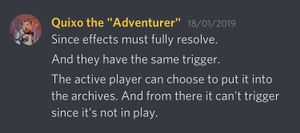Destroyed
When a card is destroyed by a card effect or when a creature has damage on it equal to or greater than its power, that card is tagged for destruction. After it is tagged, then that card’s “Destroyed:” abilities resolve, and finally the tagged card is placed into its owner’s discard pile.
If multiple cards are simultaneously tagged for destruction, the active player chooses the order in which to resolve the “Destroyed:” abilities of any of those cards. All the tagged cards are put into their owners’ discard piles simultaneously, and the active player chooses the order in which those cards are arranged in their owner’s discard piles.
Once a creature has been tagged for destruction, the only thing that can remove this tag is a replacement effect that uses the word “instead” and replaces the destruction of that creature. An effect that heals a tagged creature does not remove the destroyed tag. An effect may move a tagged creature to a different out-of-play area (such as the hand or archives), but that creature is still considered to have been “destroyed” for the purposes of card effects.
If a “Destroyed:” ability causes more cards to be destroyed, they are also tagged for destruction, and their “Destroyed:” effects will also resolve before cards are placed in the discard pile. None of the cards that have been tagged for destruction are put into their owners’ discard piles until all “Destroyed:” effects have finished resolving.
Players cannot choose to sacrifice or destroy a card that is already tagged for destruction. A card that is already tagged for destruction cannot be tagged for destruction again, and any effect that attempts to destroy or sacrifice that card fails. That card still only resolves its “Destroyed:” abilities once.
A card only resolves “Destroyed:” abilities that it had at the time it was tagged for destruction. If a card gains a “Destroyed:” ability after it is already tagged, that ability does not resolve.
If an ability resolves “after” a card is destroyed, the card with that ability must be in play at the time the destroyed card leaves play.
Cards that are sacrificed also count as being destroyed. They are tagged for destruction following the same process outlined above.
Example: Dan has Archimedes in the middle of 4 other creatures and his opponent plays Gateway to Dis, destroying all creatures. First, all of Dan’s creatures are tagged for destruction. Then Archimedes’ neighbors “Destroyed:” effects resolve, archiving them. The battleline immediately collapses, but Archimedes’ new neighbors have already been tagged for destruction and cannot gain a new “Destroyed:” ability, so they are placed in the discard pile along with Archimedes.
Example: Emily has a Jehu the Bureaucrat, Duma the Martyr with 2 damage, and Commander Remiel with 1 damage in play. Her opponent plays a Poison Wave, dealing 2 damage to each creature. This damage causes Duma the Martyr and Commander Remiel to be tagged for destruction. Duma the Martyr’s “Destroyed:” effect resolves, healing Jehu the Bureaucrat and Commander Remiel. Since Commander Remiel was already tagged for destruction, it still goes to the discard pile with Duma the Martyr, but Jehu the Bureaucrat survives unscathed.
Example: Marcus has a Groggins with a Phoenix Heart in play. His opponent, Janelle, has a Dust Imp with a Soulkeeper, a Drumble, and a Shaffles in play. Marcus fights Dust Imp with Groggins, causing Dust Imp to be tagged for destruction. Dust Imp’s “Destroyed:” ability and the “Destroyed:” ability that Soulkeeper grants it both trigger simultaneously. Marcus chooses to let his opponent gain the 2 Æmber first, then resolve the Soulkeeper, which will destroy Marcus’s most powerful creature— Groggins. When Groggins is tagged for destruction, the Phoenix Heart attached to it resolves, returning Groggins to Marcus’s hand and dealing 3 damage to each other creature. This damage then tags Drumble and Shaffles for destruction. Finally, all the destroyed creatures still in play (Dust Imp, Drumble, and Shaffles) are placed in their owner’s discard pile in the order of the active player (Marcus’s) choice.
Related Topics: Damage, Leaves Play
Commentary

The cards are not considered to be "destroyed" until the cards are placed in the discard pile; a Tolas that has been upgraded with a Soulkeeper that is being destroyed won't ever earn an Æmber because Tolas and any creature Soulkeeper destroys will both be destroyed at the same time.



